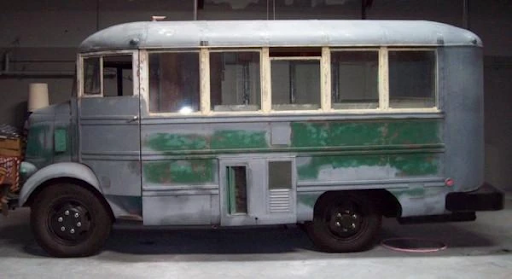
The History of RVing - The Frantic 40s
Welcome to the 1940s! A time of political madness, global war, atomic bombs, and the invention of both the Frisbee and Tupperware. All equally important historical happenings.
In Canada, we saw camping take off like geese in fall after WWII. An increase in leisure time and access to motor vehicles, along with improved infrastructure made it a less elite activity each year. And that was something both provincial and federal levels of government took note of, with agreements to develop campgrounds every 160 km along the Trans-Canada Highway, which became as popular as Tiger King during the early 2020s lockdown.
Private campgrounds also flourished, with organizations like the BC Lodging and Campgrounds Association formed to help promote Canadian camping and RVing. Remember the CCA was already formed in 1936 so there was a head start here!
However, the recreational side of the RV industry halted with World War II, with trailers serving as housing for war workers mostly. In 1942, the Palace Corporation debuted a new type of trailer that expanded out on both sides and featured four rooms and a shower bath. These models were purchased by the thousands by the US Army to be used as base housing for the enlisted men and their families.
However, once the Allies triumphed, industry resumed, and the world of RVing flourished, with innovations occurring seemingly overnight.
Manufacturers began to build housecars, the first of recognizable (to modern eyes) motorhomes. And while being sold at a price not casually affordable to the general masses, the spark was lit for interest in hitting the road in your own motorized trailer.
A perfect example of these are the Howard Hughes buses, built by the movie producer and director in 1940. There are a recorded eight built to be used as mobile dressing rooms for location filming.

(This 1940 GMC was up for auction back in 2011, and reportedly built by Hughes for Jane Russel’s use on set for ‘The Outlaw’)
The buses had a mahogany interior, with a full instrumental dashboard, airplane seats, full bath with toilet and shower, electric fridge, stove and oven in a kitchenette, swamp cooler and A/C, and a generator to provide electricity for really remote locations. Truly, an example of luxury when it came to mobile living quarters.
But it wasn’t just over the top luxury, as birthed in the 30s, teardrop trailers continued to rise in popularity and design in the 40s and into the 50s. Plans for them appeared in Popular Mechanics and Mechanix Illustrated, with most in the early days built by individuals following said plans. They were primarily constructed with 4’ by 8’ plywood sheets and hardwood spars – materials available from surplus markets as equipment like tents and sleeping bags entered the market after WWII. Chassis would be made of steel U channel or round steel tubing, with tires often from salvaged Jeeps (some exteriors were reportedly made from wings of WWII bombers).

(1940s magazine article describing how to build a teardrop trailer)
Starting in 1944 (and spanning into the 50s), the Redman Trailer Company in Michigan, USA, developed the New Moon line of trailers, which claimed to be the world’s largest trailers (and dubbed so in 1947), and were to be available as housing for war workers. The trailers were so successful the company took the name of these trailers as New Moon Homes.

(1940 New Moon)

(1941 New Moon Advertisement)
Now if you recall, back in 1917 aviator Glenn Curtiss built the Aerocar Land Yacht. This wasn’t the last time air and land met. From 1946-1959, the Spartan Aircraft Company (famous since the late 20s for luxury aircraft) was built from the bones of the Tulsan Mid- Continent Aircraft Manufacturing Company by oil baron William G. Skelly.
Under the renamed company he also began the Spartan School of Aeronautics, which continues as a private for-profit aviation college in Tulsa, Oklahoma. It continues to train pilots and mechanics to this day!
Spartan produced an extensive 19 model line of aluminum trailers. Taking construction techniques and designs learnt after years designing airplanes, the trailers had a modern design with deco elements, and were furnished in the latest styles from floor to ceiling. As the “Cadillac” of trailers at the time, these trailers were not for the average household with prices hitting above $4,000 USD (at the time).
They manufactured aircraft until after WWII, with J. Paul Getty acquiring the company in 1935. Getty transitioned them entirely to manufacturing trailers under the Spartan Manor brand, but ended all production in 1961.
Post-war it seemed bigger = better in the minds of V developers, who continued to put out more and more luxurious builds. In 1947, Streamlite Trailer Company in Illinois, USA, offered the 3-roomed ‘Shoreland Tandem Town and Country,’ that boasted extra insulation (a precursor to winter packages perhaps), various hardwood finishes, and chromium hardware and electric light fixtures. Many of these features would later become industry standards.
And finally, before we say goodbye to the forties to welcome the 50s and all its landslide expansion, let’s check out the Flxible Bus Company (no, it’s not a typo). They began a division in 1948 making Land Cruiser custom coaches. And you may ask, why is this so important?
Well my friend, spoilers for the 50s, this division was sold in 1955 and renamed Custom Coach Corportant, which continues to convert bus chassis to this day! Making it one of the longest lasting RV developers we’ve seen so far.

(Interior of 1949 Royal Mansion)
